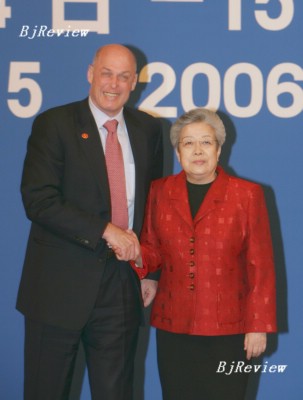
People’s Daily : Is China’s economic development balanced?
Chen Dongqi: Imbalances in China’s economic development are gradually being corrected. During the first three quarters of 2006, the total value of retail sales increased and consumption of housing, cars, IT products, tourism and education grew. Despite the rapid growth of investment, which is still the primary engine of economic growth, the actual growth rate has in fact declined, while the consumption growth rate has remained steady at around 13 percent. This is an important new trend in the balance of economic development.
What are the main trends in changes of industry?
Primary, secondary and tertiary industries have become more balanced. In the third quarter of 2006, investment in the service industry, particularly in transportation, grew rapidly. Growth in service industries accelerated the flow of logistics and increased the mobility of people. Growth in catering, tourism, finance, insurance, securities, research, education, entertainment, health care and other service industries gained pace. Although the secondary industry grew rapidly, the tertiary sector grew even faster.
In the secondary industry, structural adjustments are taking place in the manufacturing sector. The share of general-purpose, special-purpose and large-scale equipment in the entire product lineup grew last year, reflecting a better and more balanced industrial structure.
In what other areas is the economic balance reflected?
In terms of regional economic development, originally the southeastern coastal areas contributed most to economic growth. But in recent months the central and western regions have shown great potential and made a bigger contribution. During the first three quarters of 2006, the growth rate of investment in east China was 26 percent, in central China it exceeded 40 percent and in the west it was 33 percent. This indicates that the original economic development mode is changing.
With regard to the relationship between urban and rural economies, the urbanization process is accelerating, as is rural construction. There are more water, electricity, road and gas projects underway in rural areas as farmers’ income is increasing. The living standard of farmers has greatly improved. This is another important trend in balanced economic development.
What are the effects of fine-tuning the yuan exchange rate?
Over the last two years, the Chinese Government has been progressively fine-tuning the exchange rate. Generally speaking, the policy is moving in the right direction and has yielded some positive results. In the near future, it is likely that China will continue to pursue this same policy, perhaps increasing momentum, but only slightly. It is best if the inflation rate is under 5 percent. Problems arising from economic operations are both old and new and should be addressed individually. We cannot expect to settle all the problems in the short term. By implementing a policy step by step, making regular minor adjustments in accordance with actual conditions, we can avoid the risk of large fluctuations.
As its next step, the government should curb excessive investment credit and tighten monetary policy, in particular interest rates. Personally, I think it is best to continue gradually raising interest rates, which are binding for all individuals and businesses. Any adjustments should be moderate and gradual, rather than intense and abrupt. n
|
